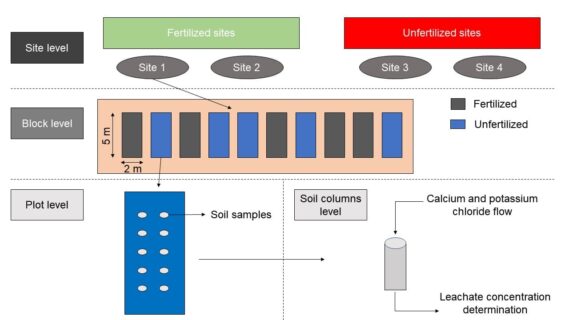Soil phosphorus mobilization as affected by long-term organic fertilization in a tropical Regosol
Authors
- Kalline De Almeida Alves Carneiro 1
-
Tancredo Augusto Feitosa De Souza
*
 1
1
- Gislaine Dos Santos Nascimento 1
- Vânia Da Silva Fraga 1
- Bruno de Oliveira Dias 1
Abstract
Purpose: Phosphorus mobilization (PM) in tropical Regosols may be harmful to the environment and water quality. It is expected that high contents of soluble phosphorus in sandy soils may promote the P leaching through the transport of the available phosphorus from the soil surface to deeper layers. This study aimed to evaluate the PM in a tropical Regosol by using soil columns (10 cm depth) during steady saturated water flow and PM was correlated with Fe and Al oxides.
Method: Soil samples were collected in four sites characterized as smallholder farming systems that shared the same land uses and soil type with each other. P content was estimated by using water, Melich-1, and resin extraction protocols. We estimated the contents of Fe and Al oxides with high and low crystallinity. The miscible displacement technique was used to simulate P leaching in soil columns, and the leached P was quantified by colorimetry.
Results: Soil P loss showed a significant coefficient of determination (r2 > 0.80) with P content. We found the highest values of Fe oxalate (0.30 mg/g), and Al oxalate (0.53 mg/g) in the long-term organic fertilization, while the highest values of Fe dithionite and Al dithionite were found with the non-fertilization system.
Conclusion: The highest soil pH (8.01), soil P content by different extractors (P mehlich-1, P water, and P resin were 54.45, 14.36, and, 38.70 mg/kg, respectively), and soil P loss (128.83 mg/kg) were observed with the long-term non-fertilization system.
Highlights:
- The continuous use of higher rates of farmyard manure influences the soil chemical properties and P loss in a Regosol.
- Areas with long-term use of farmyard manure show a high rate of P mobilization.
- Areas with the addition of high rates of farmyard manure in a short-term schedule may increase P mobilization.
- The use of farmyard manure improves the organic matter accumulation, and available phosphorous, which leads to high vertical P loss.




